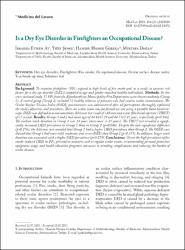| dc.contributor.author | Ay, İbrahim Ethem | |
| dc.contributor.author | Yiğit, Şenol | |
| dc.contributor.author | Göbeka, Hamidu Hamisu | |
| dc.contributor.author | Doğan, Mustafa | |
| dc.date.accessioned | 2023-04-17T07:13:08Z | |
| dc.date.available | 2023-04-17T07:13:08Z | |
| dc.date.issued | 2023 | en_US |
| dc.identifier.issn | 2532-1080 | |
| dc.identifier.uri | https://dx.doi.org/10.23749/mdl.v114i2.13472. | |
| dc.identifier.uri | https://hdl.handle.net/20.500.12933/1458 | |
| dc.description.abstract | Background: To examine firefighters (FFs) exposed to high levels of fire smoke and, as a result, to uncover risk factors for dry eye disorder (DED) compared to age-and gender-matched healthy individuals.
Methods: In this cross-sectional study, 51 FFs from the Afyonkarahisar Municipality Fire Department were chosen at random (group 1). A control group (group 2) included 51 age- and gender-matched healthy individuals. The Ocular Surface Disease Index (OSDI) questionnaire was administered after all participants were thoroughly explained the study's objectives and procedures. Then, using a portable hand biomicroscope, an ocular exam was performed on-site. DED was defined as a non-anesthetic Schirmer test result of <10 mm and/or a tear film break-up time (TBUT) of <5 seconds.
Results: Groups 1 and 2 had mean ages of 44.82±7.29 and 44.73±7.41 years, respectively (p=0.946). The median work duration in group 1 was 14 years (min-max: 1-27 years). TBUT test revealed a significantly increased DED prevalence in group 1 than group 2 (p=0.046). Despite the non-significant difference (p=0.276), Schirmer test revealed that group 1 had a higher DED prevalence than group 2. The OSDI score revealed that group 1 had more mild, moderate, and severe DED than group 2 (p=0.359). Longer work duration was associated with a higher DED prevalence (p=0.179).
Conclusions: Given the high prevalence of fire smoke-induced DED in FFs, preventive measures such as regular ocular exams, encouraging personal protective equipment usage, and health education programs can assist in avoiding complications and reducing the burden of ocular diseases. | en_US |
| dc.language.iso | esp | en_US |
| dc.publisher | Mattioli | en_US |
| dc.relation.isversionof | 10.23749/mdl.v114i2.13472. | en_US |
| dc.rights | info:eu-repo/semantics/openAccess | en_US |
| dc.subject | Dry Eye Disorder | en_US |
| dc.subject | Firefighters | en_US |
| dc.subject | Fire Smoke | en_US |
| dc.subject | Occupational Disease | en_US |
| dc.subject | Ocular Surface Disease İndex | en_US |
| dc.subject | Tear Break-Up Time; | en_US |
| dc.subject | Schirmer test | en_US |
| dc.title | Is a dry eye disorder in firefighters an occupational disease? | en_US |
| dc.type | article | en_US |
| dc.authorid | 0000-0002-3468-7096 | en_US |
| dc.department | AFSÜ, Tıp Fakültesi, Cerrahi Tıp Bilimleri Bölümü, Göz Hastalıkları Ana Bilim Dalı | en_US |
| dc.contributor.institutionauthor | Ay, İbrahim Ethem | |
| dc.contributor.institutionauthor | Yiğit, Şenol | |
| dc.contributor.institutionauthor | Göbeka, Hamidu Hamisu | |
| dc.contributor.institutionauthor | Doğan, Mustafa | |
| dc.identifier.volume | 114 | en_US |
| dc.identifier.issue | 2 | en_US |
| dc.relation.journal | La Medicina del lavoro | en_US |
| dc.relation.publicationcategory | Makale - Uluslararası Hakemli Dergi - Kurum Öğretim Elemanı | en_US |
















